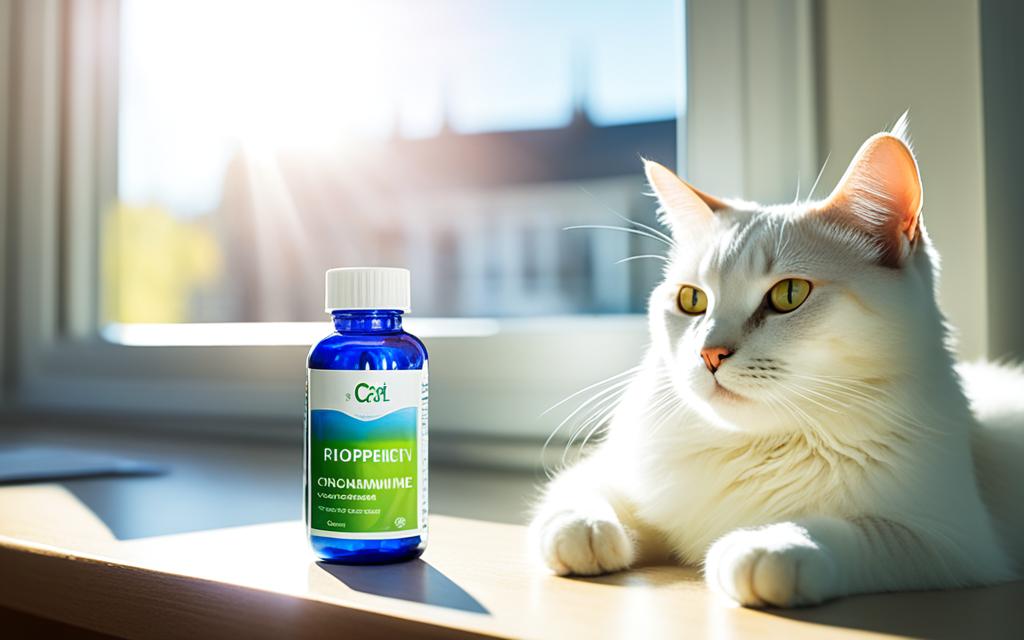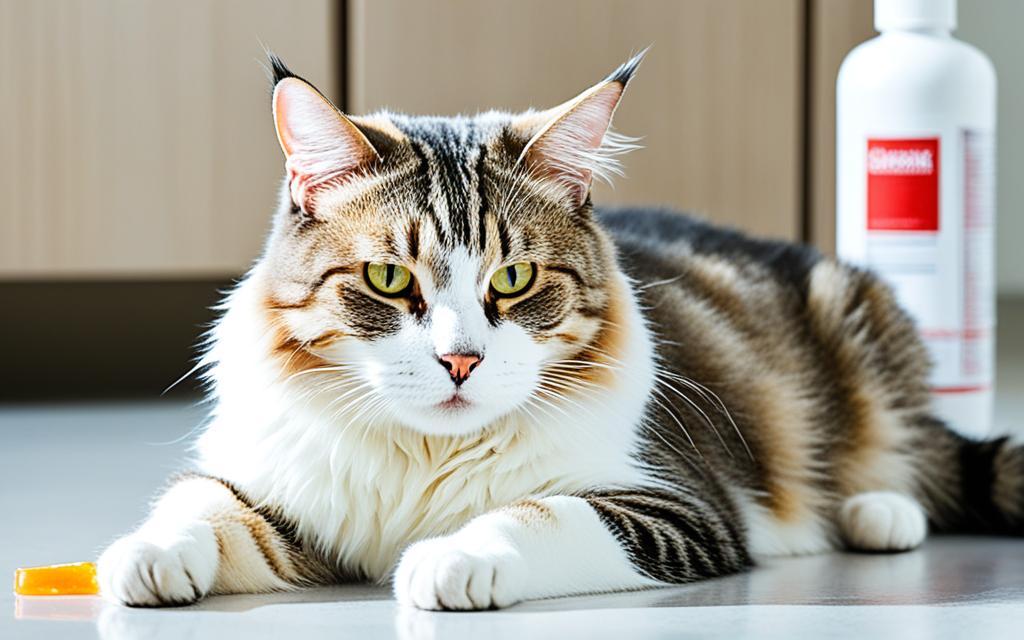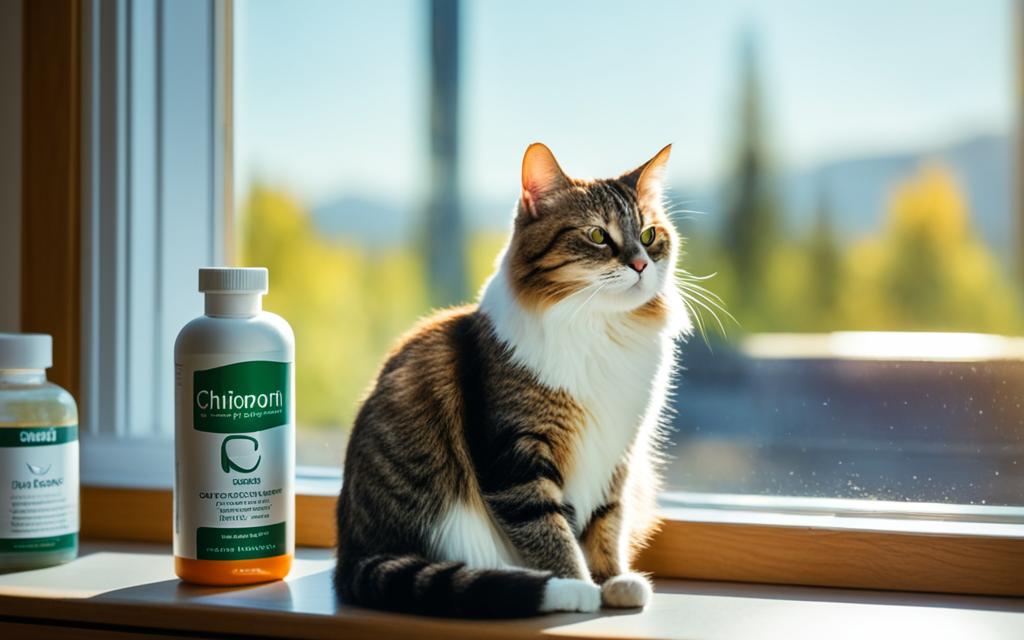Chlorpheniramine for cats: Uses, Side Effects & Dosage Guide
If you have a cat, you may see your pet struggle with allergies or skin problems. These may need medication. Veterinarians sometimes recommend chlorpheniramine, an antihistamine. It’s often used in cats, ferrets, and birds more than in dogs. This guide will look into using chlorpheniramine with cats. It will cover the benefits, risks, and the right amount to use. This helps you understand your pet’s care better.
Key Takeaways
- Chlorpheniramine helps manage allergies and skin issues in cats.
- It’s not directly approved by the FDA for pets, but vets may still use it in some cases.
- The medicine might cause sleepiness, throwing up, or not wanting to eat.
- It’s vital to know how it might react with other drugs. Too much can be very harmful.
- Always use the correct dose for your cat, as your vet advises. This ensures safety and success with the treatment.
What is Chlorpheniramine?
Definition and Overview
Chlorpheniramine is a type of antihistamine. It blocks histamine effects, lessening allergic reactions3. This medicine helps with itching, sneezing, and a runny nose in cats. You can find Chlorpheniramine in tablets, syrups, and other forms. Veterinarians use it a lot, even though it’s not always specifically for cats.
It’s great for treating allergies in pets. Chlorpheniramine makes itchiness and other allergy symptoms better4. Because of this, it’s a top pick for both pet owners and vets.
The main ingredient in Chlorpheniramine is chlorpheniramine maleate. It comes in different strengths and forms, like tablets and syrups3. This variety helps vets give the right dose to each cat.
“Chlorpheniramine is an antihistamine that blocks the release of histamine in the body, which causes itchiness.”4
Chlorpheniramine isn’t just for allergies. It’s also in some tick products and used for pets with memory problems3. This shows how useful it is in vet care in many ways.
In short, Chlorpheniramine is a common antihistamine for cats. It comes in different forms and helps with many allergy symptoms. Vets often use it because it works well with other medicines345.
Uses of Chlorpheniramine for Cats
Chlorpheniramine is an antihistamine used in cats and dogs for allergy symptoms6. Vets prescribe it for cats with various allergies, like those from the environment, food, or fleas7. It can also treat atopy, a skin condition that makes cats inflamed and itchy7. By cutting down on histamine, it relieves allergic signs in cats6.
It starts to work in about an hour6. Cats usually take 1-2mg of it every 8-12 hours6. The pills for pets are 4mg, so cats get 1-2mg doses every 8-12 hours8. Vets typically give cats 1-2mg of chlorpheniramine every twelve hours7.
It combats different pet allergies like those from contact, inhaling, or drugs, and eases itching8. It’s good with Cat Flea Allergy Dermatitis, too, even though it’s not FDA approved for animals8.
But, chlorpheniramine can lead to drowsiness, vomiting, and more in cats687. Seizures and overdose are also possible. If your cat takes too much, it’s an emergency7.
“Chlorpheniramine is widely accepted for veterinary use in dogs and cats, though it is not FDA approved for that purpose.”
Always listen to what your vet says about giving chlorpheniramine to your cat. Watch for bad reactions. With the right care, it can really help your cat’s allergies and skin problems.
How Chlorpheniramine Works
Chlorpheniramine is an antihistamine that blocks histamine’s effects6. Histamine is a chemical that causes inflammation and itching in response to allergens7.
Chlorpheniramine stops histamine from causing these bad effects by binding to its receptors. This way, it helps with allergy symptoms and some skin conditions in cats7.
Understanding the Mode of Action
Chlorpheniramine is understood to work as an antihistamine. It competes with histamine for binding to H1 receptors all over the body3. This action stops histamine from causing inflammation, which reduces allergy symptoms like itching and redness.
This medicine is especially helpful for cats with allergies. It can manage symptoms caused by pollen, dust mites, and specific foods7.
Chlorpheniramine halts the chain of inflammatory reactions caused by histamine. This control eases the discomfort of allergic reactions in cats.
Besides fighting allergies, chlorpheniramine has slight sedative effects7. This can aid in handling specific skin problems or behavioral issues in cats. The working of its sedative effects is not fully known, but it involves the central nervous system.
“Chlorpheniramine is a versatile antihistamine that can provide relief for cats suffering from various allergic and skin-related conditions by blocking the effects of histamine, a key mediator of the allergic response.”
Chlorpheniramine’s main function is to block histamine, which helps relieve allergy symptoms. This is why it’s a valuable medicine for veterinarians in treating cat health and well-being673.
Chlorpheniramine for Cats: Benefits
Using chlorpheniramine in cats helps with allergies and skin problems. It’s an antihistamine that blocks histamine, fighting allergic symptoms. This includes itchiness, sneezing, and swelling, making your cat feel better9.
Based on a study, 73% of itchy cats saw improvement with chlorpheniramine maleate9. It comes in different forms like tablets and syrups9. Chlorpheniramine is not just for allergies. It also treats skin issues like atopic dermatitis by calming inflammation10.
The best part is, chlorpheniramine is affordable. It’s a generic drug, so it’s not as expensive as some others. Plus, veterinarians can prescribe it beyond its usual use, making it cost-effective for pet owners9.
Yet, chlorpheniramine may not suit every cat. Some might get side effects like tiredness, a dry mouth, or trouble peeing if they get too much. Always use the right dose and keep an eye on your cat’s health while using it910.

To sum up, chlorpheniramine is great for managing allergies and skin issues in cats. It’s affordable and easy to find, but not without some risks. Working with your vet is key to making sure it helps your cat safely91011.
Dosage and Administration
Dosage Guidelines and Frequency
Chlorpheniramine helps with allergies and is often used by vets for cats. Usually, they suggest giving 1-2 milligrams of chlorpheniramine by mouth every 12 hours7. But, the dosage might change based on what the cat needs. It also varies depending on the condition and the cat’s other medicines7.
It’s really important to use chlorpheniramine as the vet tells you to. How you give it and how much can change how well it works and if it’s safe12. If you miss a dose, just wait. Give the next dose at the usual time, unless the vet says otherwise.
Chlorpheniramine for cats comes in different forms. There are chewable or regular tablets, syrups, and even gels you rub on their skin12. But, the main side effect is that it can make cats sleepy12.
Using 0.1 mg to 0.4 mg per pound every 8 to 12 hours is normal for dogs with this medicine12. For cats, the usual dose is 2 mg every 8 to 12 hours5. If a cat needs to calm down, they might get 1-2 mg every 12-24 hours5.
If a cat takes too much, it can be bad. This is especially true if it’s mixed with other drugs like pseudoephedrine or acetaminophen12. Keep the medicine in a cool place, between 50°F and 85°F, to make sure it works right12.
Chlorpheniramine starts working within 48 hours for most cats12. Always talk to the vet first to figure out the best dose. Keep a close eye on how your cat reacts to it1275.
Potential Side Effects and Precautions
Chlorpheniramine is usually fine for cats, but it might cause some issues sometimes13. It can make cats feel sleepy or less active. This often gets better as they get used to it13. However, cats might also vomit or have diarrhea. They could eat less, get constipated, or even become more energetic and drool.
This medicine should be used carefully in cats with specific health problems. These problems might include eye issues, high blood pressure, or heart trouble131. If the cat is pregnant or nursing, keep a close eye on them when using this medicine1. Talking with your vet and following their advice is crucial to use this medicine safely and well.
- Drowsiness and sedation are the most common side effects, but may decrease over time13
- Other potential side effects include vomiting, diarrhea, loss of appetite, constipation, excitement, and drooling131
- Caution is advised in cats with certain medical conditions like glaucoma, high blood pressure, or heart disease131
- Pregnant or lactating cats should be monitored closely when using chlorpheniramine1
- Always consult a veterinarian and follow their instructions closely for safe and effective use

Overall, chlorpheniramine is usually okay for cats. But, it’s good to know about the possible side effects. Be careful, especially with sick or pregnant cats. Remember, always talk to your vet and do what they say to keep your cat safe and well with this medicine13141.
Chlorpheniramine Alternatives
Chlorpheniramine is a standard antihistamine for cats. Yet, vets might look at other medications for allergies or skin issues15. Allergies impact 10 to 15 percent of cats15. Vets could suggest other options, depending on what the cat reacts to best.
Great replacements for chlorpheniramine in cats include:
- Hydroxyzine: It fights allergy symptoms in cats2.
- Diphenhydramine: For cats needing allergy care2.
- Corticosteroids: These lessen swelling and itching from allergies2.
- Omega-3 and omega-6 supplements: Improve skin and ease allergic reactions15.
A mix of these treatments might be the best for a cat’s health15. Talking to a vet will help pick what’s best for the cat.
| Medication | Mechanism of Action | Potential Benefits | Potential Drawbacks |
|---|---|---|---|
| Hydroxyzine | Antihistamine | Manages allergy symptoms well | Drowsiness and dry mouth can happen |
| Diphenhydramine | Antihistamine | It’s for treating cat allergies | It may cause similar effects as hydroxyzine |
| Corticosteroids | Anti-inflammatory | Lessen itching and swelling due to allergies | Bad effects from long use, such as weight gain |
| Omega-3 and omega-6 fatty acids | Nutritional support | They boost skin health and reduce allergies | Results may be slow, and effect on all cats are unsure |
In deciding on the right replacement for chlorpheniramine, working closely with a vet is crucial. They’ll guide you based on your cat’s needs and health15162.
Chlorpheniramine for Cats: Comparison to Similar Drugs
Managing allergies and skin issues in cats often involves chlorpheniramine. It’s one of the antihistamines that vets might recommend. It’s cheaper and more common than some newer antihistamines like loratadine or cetirizine17.
Chlorpheniramine stands out because it helps allergy symptoms quickly. It can start working in just 4 hours. It also reduces itching well within a day18. It can be used in both dogs and cats, and it’s safe with many other drugs19.
Yet, sometimes chlorpheniramine can make cats more drowsy or cause other issues. Choosing the right antihistamine depends on what’s being treated, how the cat responds, and what you can afford. This includes looking at the different side effects of each option17.
Vets often try different antihistamines to see what works best for a cat. For instance, diphenhydramine (known as Benadryl) is commonly tried. But, it’s not officially for use in animals. Benadryl should be given at 1 milligram per pound of a cat’s weight. Possible effects include feeling down, dry mouth, throwing up, and holding urine17.
In the end, chlorpheniramine is a helpful choice for cat allergies. But, it might not be the top pick when it comes to new antihistamines. Vets might suggest other options or a unique mix to suit your cat best.
Conclusion
Chlorpheniramine is often used to help with allergies and skin problems in cats. It’s vital to know its limits and risks. The key cat allergies are from fleas and certain foods like beef, pork, and chicken20. Cats might also itch a lot due to things in the environment. Treating this may include medicines like chlorpheniramine20.
Chlorpheniramine helps, but results in cats can vary. No antihistamine has been clearly effective for cat skin allergies21. Other options like immunotherapy, palmitoylethanolamide, and ciclosporin look better in some tests. They can help a lot with itching and other issues21. Sometimes, using different medicines together works best. For example, pairing hydroxyzine with chlorpheniramine may be more effective in some instances22.
It’s key for cat owners to talk with a vet. They can figure out how to use chlorpheniramine safely or try other treatments. The focus should be on what’s best for each specific cat. This means knowing the limits of chlorpheniramine and looking into new treatments. Finding a mix that works can truly help cats with allergies.
FAQ
What is chlorpheniramine?
What are the uses of chlorpheniramine for cats?
How does chlorpheniramine work?
What are the benefits of using chlorpheniramine for cats?
What is the recommended dosage of chlorpheniramine for cats?
What are the potential side effects of chlorpheniramine in cats?
Are there any alternatives to chlorpheniramine for cats?
How does chlorpheniramine compare to similar antihistamine medications for cats?
Source Links
- Chlorpheniramine for Cats and Dogs
- Chlorpheniramine Maleate | VCA Animal Hospitals
- CHLORPHENIRAMINE MALEATE – Mar Vista Animal Medical Center
- Chlorpheniramine (OTC)
- Chlorpheniramine Maleate 4mg 1000 Tablets Pet Anti-Allergy Medication
- Chlorpheniramine 4 mg Tabs 100 ct | 1800PetMeds
- Chlorpheniramine For Cats: Uses, Dosage, & Side Effects – CatTime
- Chlorpheniramine Maleate: Pet Allergy Relief: Dogs & Cats: 4mg Tablets
- Chlorpheniramine Maleate (Chlor-Trimeton)
- Chlorambucil | Texas West Animal Health
- Helping the Medicine Go Down
- Chlorpheniramine Maleate (Chlor-Trimeton®) for Dogs and Cats – PetPlace
- Chlorpheniramine: Side Effects, Uses, Dosage, Interactions, Warnings
- Chlorpheniramine 40 Mg/ml Transdermal 1 Ml | 1800PetMeds
- What Can I Give My Cat for Allergies?
- Chlorpheniramine (Rx)
- What to Know About Antihistamines for Cats
- 1800PetMeds
- 1800PetMeds
- Allergies in Cats | VCA Animal Hospitals
- Therapy for feline allergic dermatitis
- Paper: Efficacy of dimetinden and hydroxyzine/chlorpheniramine in atopic dogs: a randomised, controlled, double-blinded trial







